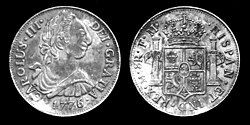Peso
The peso is a unit of currency. In Spanish “peso” means weight. It was the main Spanish coin of colonial times and it was worth eight reales. This is the famous Spanish dollar or “piece of eight” and later became called the peso. The peso coin weighed 27 grams and was of 92 per cent pure silver. It was the template for the coins of the United States and one silver dollar equaled exactly one peso. The following articles contain more information (list may not contain all historical pesos):
Current
- Argentine peso (ISO 4217: ARS)
- Chilean peso (CLP)
- Colombian peso (COP)
- Cuban peso (CUP)
- Cuban convertible peso (CUC)
- Dominican peso (DOP)
- Mexican peso (MXN, previously MXP)
- Philippine peso (PHP)
- Uruguayan peso (UYU)





